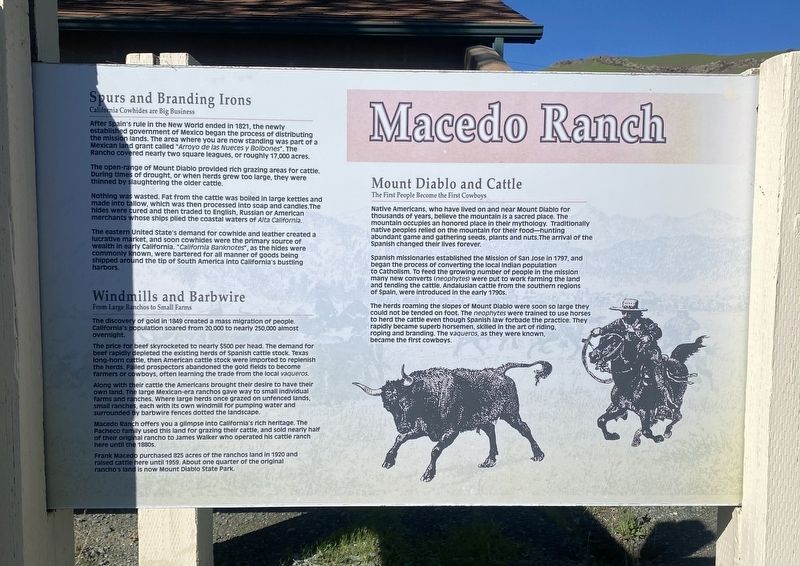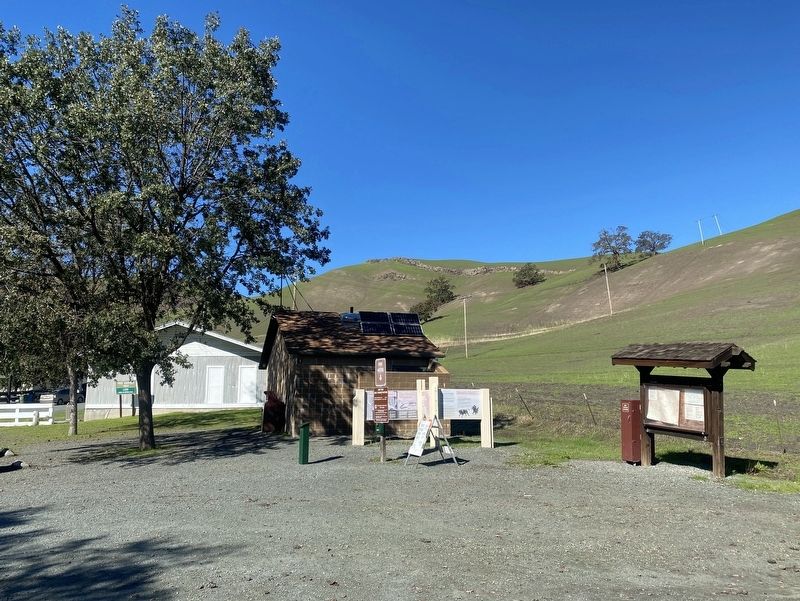Alamo in Contra Costa County, California — The American West (Pacific Coastal)
Macedo Ranch
Spurs and Branding Irons
California Cowhides are Big Business
After Spain's rule in the New World ended in 1821, the newly established government of Mexico began the process of distributing the mission lands. The area where you are now standing was part of a Mexican land grant called "Arroyo de las Nueces y Bolbones". The Rancho covered nearly two square leagues, or roughly 17,000 acres. The open-range of Mount Diablo provided rich grazing areas for cattle. During times of drought, or when herds grew too large, they were thinned by slaughtering the older cattle.
Nothing was wasted. Fat from the cattle was boiled in large kettles and made into tallow, which was then processed into soap and candles. The hides were cured and then traded to English, Russian or American merchants whose ships plied the coastal waters of Alta California. The eastern United State's demand for cowhide and leather created a lucrative market, and soon cowhides were the primary source of wealth in early California. "California Banknotes", as the hides were commonly known, were bartered for all manner of goods being shipped around the tip of South America into California's bustling harbors.
Windmills and Barbwire
From Large Ranchos to Small Farms
The discovery of gold in 1849 created a mass migration of people. California's population soared from 20,000 to nearly 250,000 almost overnight.
The price for beef skyrocketed to nearly $500 per head. The demand for beef rapidly depleted the existing herds of Spanish cattle stock. Texas long-horn cattle, then American cattle stock were imported to replenish the herds. Failed prospectors abandoned the gold fields to become farmers or cowboys, often learning the trade from the local vaqueros. Along with their cattle the Americans brought their desire to have their own land. The large Mexican-era ranchos gave way to small individual farms and ranches. Where large herds once grazed on unfenced lands, small ranches, each with its own windmill for pumping water and surrounded by barbwire fences dotted the landscape.
Macedo Ranch offers you a glimpse into California's rich heritage. The Pacheco family used this land for grazing their cattle, and sold nearly half of their original rancho to James Walker who operated his cattle ranch here until the 1880s.
Frank Macedo purchased 825 acres of the ranchos land in 1920 and raised cattle here until 1959. About one quarter of the original rancho's land is now Mount Diablo State Park.
Mount Diablo and Cattle
The First People Become the First Cowboys
Native Americans, who have lived on and near Mount Diablo for thousands of years, believe the mountain is a sacred place. The mountain occupies an honored place in their mythology. Traditionally native peoples relied on the mountain for their food-hunting abundant game and gathering seeds, plants and nuts. The arrival of the Spanish changed their lives forever.
Spanish missionaries established the Mission of San Jose in 1797, and began the process of converting the local Indian population to Catholism. To feed the growing number of people in the mission many new converts (neophytes) were put to work farming the land and tending the cattle. Andalusian cattle from the southern regions of Spain, were introduced in the early 1790s.
The herds roaming the slopes of Mount Diablo were soon so large they could not be tended on foot. The neophytes were trained to use horses to herd the cattle even though Spanish law forbade the practice. They rapidly became superb horsemen, skilled in the art of riding, roping and branding. The vaqueros, as they were known, became the first cowboys.
Topics. This historical marker is listed in these topic lists: Agriculture • Native Americans • Parks & Recreational Areas • Settlements & Settlers. A significant historical year for this entry is 1821.
Location. 37° 51.742′ N, 121° 58.716′ W. Marker is in Alamo, California, in Contra Costa County. Marker can be reached from Green Valley Road. Touch for map. Marker is in this post office area: Alamo CA 94507, United States of America. Touch for directions.
Other nearby markers. At least 8 other markers are within 3 miles of this marker, measured as the crow flies. Whitegate Farm (approx. 1.1 miles away); All Wars Memorial (approx. 1.4 miles away); Osborn House (approx. 2.1 miles away); Broad Spreader of Seed Spreader Wagon (approx. 2.3 miles away); Farmall Tractor - c. 1925 (approx. 2.3 miles away); "Old Borges Ranch" (approx. 2.3 miles away); Sentinel Rock Overlook (approx. 2˝ miles away); Turritella Snail Bed (approx. 2.6 miles away).
More about this marker. The marker is located in the parking lot, near the restrooms, of the Macedo Ranch Staging Area of Mt. Diablo State Park. Somewhat oddly perhaps, the route to this entrance to the state park has no signage. But it is easy enough to find - it is at the very end of Green Valley Road.
Credits. This page was last revised on November 13, 2021. It was originally submitted on November 13, 2021, by Andrew Ruppenstein of Lamorinda, California. This page has been viewed 595 times since then and 78 times this year. Photos: 1, 2. submitted on November 13, 2021, by Andrew Ruppenstein of Lamorinda, California.

